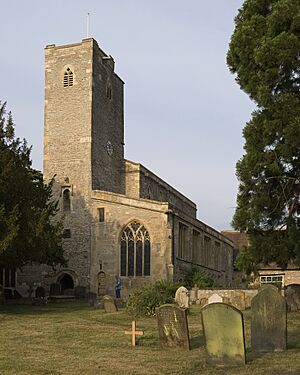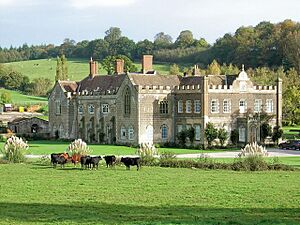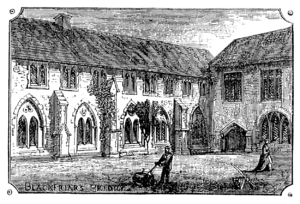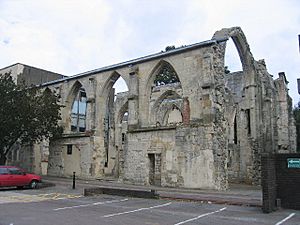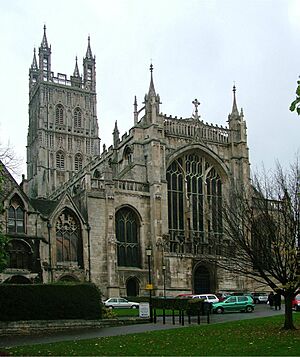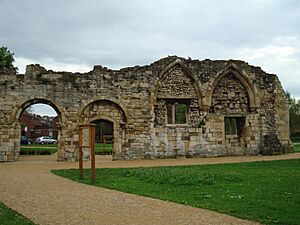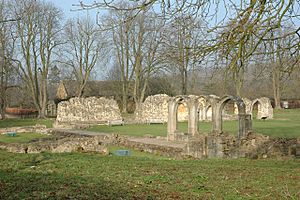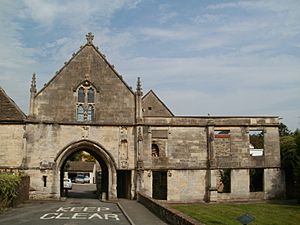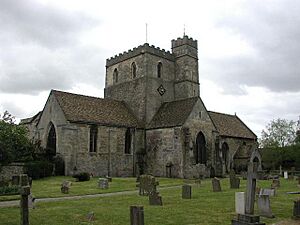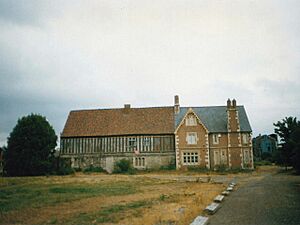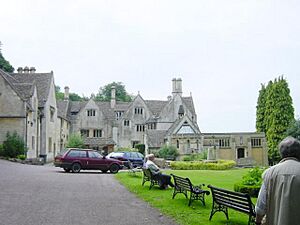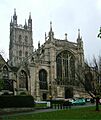List of monastic houses in Gloucestershire facts for kids
Monastic houses were places where groups of religious people, like monks or nuns, lived together. They followed strict rules and dedicated their lives to prayer and work. These houses were very important in England's history, especially during the Middle Ages. They served as centers for learning, charity, and farming.
This article lists the main monastic houses that existed in Gloucestershire, England. Some were large abbeys, while others were smaller priories or granges. Many of them were closed down in the 1500s during a time called the Dissolution of the Monasteries.
Alien houses are included, as are smaller establishments such as cells and notable monastic granges (particularly those with resident monks), and also camerae of the military orders of monks (Knights Templars and Knights Hospitaller). Monastic hospitals are included where they had the status or function of an abbey, priory, friary or preceptor/commandery.
- Abbreviations and key
| Symbol | Status |
|---|---|
| None | Ruins |
| * | Current monastic function |
| + | Current non-monastic ecclesiastic function (including remains incorporated into later structure) |
| ^ | Current non-ecclesiastic function (including remains incorporated into later structure) or redundant intact structure |
| $ | Remains limited to earthworks etc. |
| # | No identifiable trace of the monastic foundation remains |
| ~ | Exact site of monastic foundation unknown |
| ≈ | Identification ambiguous or confused |
Locations with names in italics indicate possible duplication (misidentification with another location) or non-existent foundations (either erroneous reference or proposed foundation never implemented) or ecclesiastical establishments with a monastic name but lacking actual monastic connection.
| EH | English Heritage |
| LT | Landmark Trust |
| NT | National Trust |
| Name of House | Image | Who Lived There & History | Formal Name or Other Names |
|---|---|---|---|
| Berkeley Abbey | This house was home to nuns before the year 807. It was later destroyed. A new group, secular collegiate (meaning priests who lived together but weren't monks), started here around 1019-1053. It closed around 1135 or later. The local church of St Mary might be on its original site. | Berkeley Minster
possibly Oldminster |
|
| Brimpsfield Priory | Benedictine monks lived here before 1100. It was an alien house, meaning it was controlled by a larger monastery in France. It closed in 1414. | Brimpsfield Grange | |
| Cheltenham Minster | This was an Anglo-Saxon minster (an early church with a community of clergy) from the 8th century. It was a collegiate church, not a monastery with monks. It was absorbed by Worcester before 890. | ||
| Cirencester Abbey | A Saxon minster and secular college existed here before 839. Later, Augustinian Canons Regular founded an abbey in 1131. King Henry I helped start it. The abbey closed on December 19, 1539. Today, its site is a public park. | The Blessed Virgin Mary | |
| Daylesford Monastery | This Saxon monastery was founded in 718. Land was given by King Æthelbald of Mercia. It was later given to Worcester in 841. | Daeglesford Priory | |
| Deerhurst Abbey | A Saxon minster was here in the late 7th century. Benedictine monks lived here, possibly from 715. It was destroyed around 878. It was rebuilt around 970 and again before 1056. It became an alien house, controlled by St-Denis in France. Later, it became independent in 1443. The church is now the Parish Church of St Mary. | St Mary the Virgin
St Mary the Virgin and St Denis Derehures Abbey |
|
| Farmcote Grange | This was a Cistercian monks grange. A grange was like a farm or outpost that belonged to a larger abbey. This one belonged to Hailes Abbey. | ||
| Flaxley Abbey | Cistercian monks founded this abbey on September 30, 1151. It was a "daughter house" of Bordesley Abbey. This means it was started by monks from Bordesley. It closed in 1536-7. Parts of the abbey are now part of a private house. | The Blessed Virgin Mary
Flexley Abbey Dene Abbey |
|
| Gloucester Blackfriars | Dominican Friars (also known as Blackfriars because of their black robes) started this house in 1239. It was consecrated in 1284. It closed in 1538. The building was later used as a cloth-making house. | ||
| Gloucester Greyfriars | Franciscan Friars Minor (known as Greyfriars for their grey robes) were here before 1230. King Henry III helped them. It closed in 1538. The church building was later turned into a brewery. | ||
| Gloucester Whitefriars | Carmelite Friars (Whitefriars) were founded here before 1268. Queen Eleanor was said to be one of the founders. It closed around July 25, 1538. | ||
| Gloucester Cathedral Abbey | This was a "double house" for both Benedictine monks and nuns, founded before 679. It was destroyed by Danish raids. Later, secular canons (priests) lived here. It was refounded for Benedictine monks around 1022 and again around 1058. It closed on January 2, 1540. The church then became Gloucester Cathedral in 1541 and is still active today. | The Abbey Church of Saint Peter, Gloucester
The Cathedral Church of Saint Peter and the Holy and Indivisible Trinity in Gloucester (1541) |
|
| St Oswald's Priory, Gloucester | This was a church for secular canons, traditionally founded in 660. It was refounded for Augustinian Canons Regular in the 890s by Æthelflæd. It became a priory before 1153. It closed in 1539-40. The church was later used as a parish church but was destroyed in 1643. | St Oswald, King and Martyr | |
| Hailes Abbey | Cistercian monks from Beaulieu Abbey founded this house on July 17, 1246. Richard, Earl of Cornwall, started it. It closed on December 24, 1539. Today, it is managed by the National Trust. | The Blessed Virgin Mary
Hayles Abbey Tray Abbey |
|
| Hazleton Abbey | This was a house for Cistercian monks, a "daughter house" of Tintern Abbey. The community moved here from Kingswood around 1149-50. It closed around 1150-4 and the monks moved to Tetbury. | The Blessed Virgin Mary | |
| Horsley Priory | Benedictine monks lived here. It was an alien house, dependent on a monastery in France. It was founded between 1066 and 1087. Later, it became independent and was given to Bruton Priory in 1260. It closed down, and the site is now partly a parish church and possibly a hotel. | dedication unknown
Horkeslegh Priory |
|
| Kingswood Abbey, earlier site | Cistercian Monks from Tintern Abbey founded this first site on September 7, 1139. It was later moved to a new site, but this original spot was kept as a grange (a farm). It closed on February 1, 1538. Only the gatehouse remains today. | Kingswood Grange | |
| Kingswood Abbey | This abbey was for Cistercian Monks. The community moved here from Tetbury around 1164-70. It closed on February 1, 1538. | ||
| Lechlade Priory | Augustinian Canons Regular founded this priory in the 13th century. Richard, Earl of Cornwall, helped start it. | The Priory Church of Saint John the Baptist, Lechlade
Lechelade Priory |
|
| Leonard Stanley Priory | Benedictine monks founded this priory around 1130. It was later confirmed to Gloucester Abbey in 1146. It closed in 1538. The church building is still used as a parish church today. | The Priory Church of Saint Leonard of Stanley
Stanley St Leonard Priory Stanley Priory |
|
| Llanthony Secunda Priory | Augustinian Canons Regular from Llanthony Priory in Wales founded this "daughter house" in 1136. It closed in 1538. | The Priory Church of the Blessed Virgin Mary
Lantony Priory Lanthony Priory |
|
| Minchinhampton Priory | This was for Benedictine nuns and was an alien house, controlled by a monastery in France. It was likely a grange (a farm) rather than a place where nuns lived. It was given to Syon Abbey in 1424 and later reverted to the Crown. | Minchin Hampton Priory | |
| Newent Priory | Benedictine monks lived here. It was an alien house, dependent on a French priory. It was founded before 1086. It closed in 1411. St Mary's Parish church might be the original priory church. | The Blessed Virgin Mary
Noent Priory Newenton Priory |
|
| Poulton Priory | A chantry chapel (a small chapel for prayers for the dead) was founded here in 1348. Gilbertine Canons (a type of religious order) founded a priory in 1350. It closed in 1539. The original church was demolished and replaced in 1873. | The Priory Church of Saint Mary, Poulton | |
| Prinknash Abbey | Benedictine monks founded this abbey in 1928 at St Peter's Grange. They moved to a new abbey building in 1972, but then moved back to St Peter's Grange in 2008. It is still active today. | ||
| Prinknash Abbey – former site | This was the site where the Benedictine monks of Prinknash Abbey lived from 1972 until 2008, when they moved back to their original location. | ||
| Quenington Preceptory | This was a preceptory for the Knights Hospitaller, a military religious order. It was founded between 1144 and 1162. It closed in 1540 and was demolished in the 17th century. Quenington House now stands on its site. | Queinington Preceptory | |
| Temple Guiting Preceptory | This was a preceptory for the Knights Templar, another military religious order. It was founded around 1150. It closed between 1308 and 1311. | Guiting Preceptory | |
| Temple Guiting Grange | This was possibly a grange (farm) belonging to the Knights Templars of Temple Guiting Preceptory. | ||
| Tetbury Monastery | This was a Saxon monastery founded before 680. Land was given by King Æthelred of Mercia. The site might be near the current parish church. | Tettan Monastery | |
| Tetbury Abbey | This abbey was for Cistercian monks. The community moved here from Hazleton around 1150-4, but the site wasn't suitable. They then moved to Kingswood around 1164-70. Some parts of the monastery are now in homes in Tetbury. | The Blessed Virgin Mary | |
| Tewkesbury Abbey | This began as a hermitage (a place for a hermit) around 715. It was for Benedictine monks and was a "cell" (a smaller house) dependent on Cranborne Priory. It was destroyed by Danish raids in the 9th century. It was refounded around 980 and became a large abbey in 1102. It closed on January 9, 1540. Today, it is used as a parish church. | The Abbey Church of the Blessed Virgin Mary, Tewkesbury
Theokesbury Abbey |
|
| Winchcombe Nunnery | This was a house for nuns founded in 787 by King Offa. A Benedictine monastery was later built on its site. | ||
| Winchcombe Abbey | Benedictine monks founded this abbey in 798 on the site of the former nunnery. It became a full abbey around 969. It was destroyed by fire in 1151 but rebuilt and rededicated in 1239. It closed in 1540 and was mostly demolished in 1815. | The Abbey Church of St Mary and St Kenelm, Winchcombe
Winchcombe Priory Winchelcombe Abbey |
|
| Wotton under Edge Friary | This was for Crutched Friars, a religious order. It was founded around 1349 with permission from King Edward III. It likely closed after only a few years. |
Images for kids
See also


